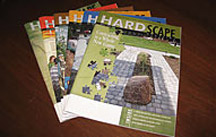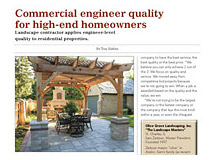Contractor Stories
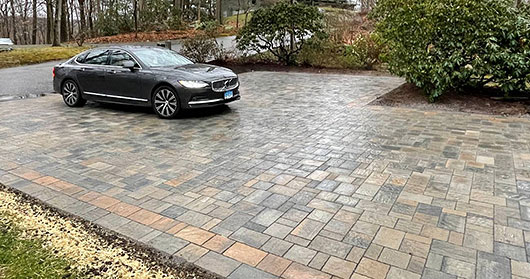
Coming back from a mountain of debt
By Tom HatlenIn the past 20 years contractor Steve Bousquet has gone on over 200 site visits to 35 different landscape companies across the country to learn how they do things and improve his company. He’s also had 46 different landscaping companies visit his business to learn from him.
The visits are part of the Proof Management networking group Steve got involved with in 2001. Proof Management is Hardscape Magazine contributor Monroe Porter’s consulting/networking organization.
Today, Steve is a senior mentor in his group and spends a lot of time helping newer contractors find their way in the business world – the same way they helped him when his company was failing. Badly.
The seeds of debt
Steve opened American Landscape & Lawn Science in 1984, and over the next 17 years expanded to offer most any lawn/landscaping-related service a client asked for. He grew the company to $800,000 in annual sales and 26 employees. When commercial bid jobs came along, they bid to win and hoped profit would tag along. (You can see where this is going….)American was losing money to the tune of $50,000 a year. Steve’s answer was to work harder, to put in more hours and sell more jobs. But, the losses continued and grew to $250,000 in unsecured debt by 2001.
Even with Steve’s education as a college graduate with an economics degree and a business minor, he wasn’t prepared to run a contracting business.
He was like a lot of contractors who feel like they're all alone and don't know what to do. He says, “Their family gives them the worst advice, ‘Sell more, buy more equipment, do more work.’ But what they really need to know are things like: charge the right amount, make a profit, watch your gross profit margins, make sure your ratios are correct.”
He says the important ratios to watch are labor to revenue, equipment to revenue, materials to sales, gross profit margin, net profit margin, sales per labor hour and sales closing ratios.
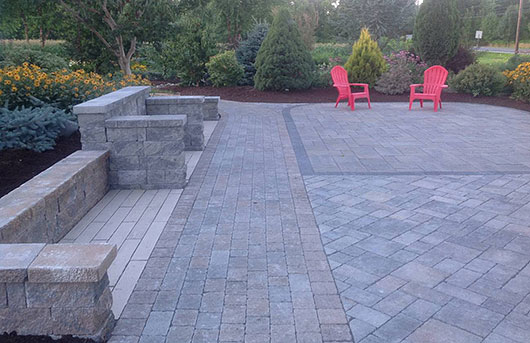
The showroom display at Steve’s facility allows people to see what the product will look like before it’s installed. Steve says it’s one of many things they do to make it easy to for clients to buy.
The breaking point
Steve was ready to give up, but instead he made a vow that he would figure things out. That’s when he found Proof Management consulting and its networking group.“When I joined that group, one of the exercises was to go through all our work, and see how much we were making per hour. And some of it, we were actually paying to do the work. So, we learned where we weren't making money, what types of jobs.”
He calculated that he only had to raise his prices $5 per man hour to make a reasonable profit. “So it wasn't crazy.”
He learned quickly, and within a week he laid off 2 managers and a designer. So, he was working even more hours to make up for their absence.
“We were not tracking our numbers. We didn't have any key performance indicators. I didn't know the ratios. I didn't know how important gross profit margins were and what gross profit margins should be. We weren't tracking. We weren't charging enough.”
The gross profit margin is important because it is a primary factor in determining your profit.
Even with immediate drastic changes it would take 7 years to get out of debt. He committed himself to studying business management to continuously improve his company.
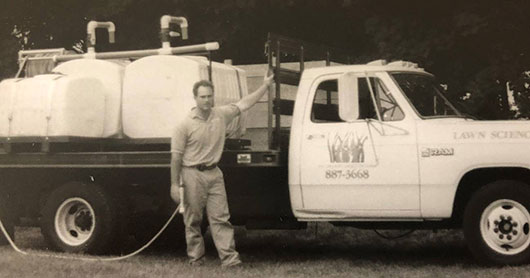
Steve pictured in the 1980s. Today, his lawn care division is going gangbusters. “In 2018, we were at $1.8 million with about 1,800 customers. Now we're at 3,300 customers and $3.2 million.”
Part of the boost came from buying another company. The other major growth factor was a change in marketing. He found they were far more successful adding new clients in neighborhoods where they already had clients. Expanding into other neighborhoods just didn’t work. “Today, we only market where we already have customers. That was the key to our growth.”
Part of the boost came from buying another company. The other major growth factor was a change in marketing. He found they were far more successful adding new clients in neighborhoods where they already had clients. Expanding into other neighborhoods just didn’t work. “Today, we only market where we already have customers. That was the key to our growth.”
Profile
American Landscape and Lawn Science LLC
North Franklin, CTFounder/Member Steven Bousquet
Contracting division
Customer base
90% residential10% commercial
Services
60% hardscaping40% landscaping
Project price range
$3,500 to $100,000Annual sales
$900,000Employees
6 employeesLawn care division
Customer base
90% residential10% commercial/contractors
Services
79% Lawn applications8% Seeding
13% Soil amendments
Individual sales
$500 to $30,000Annual sales
$3.3 million (projected)Employees
15-17Crew size is huge
One big issue Steve discovered early on was that they had too many people on their crews. “Crew size is a huge deal for making money. If there are too many guys on a crew, somebody's an audience. I have lots of data that shows that the more people there are on a crew, the less efficient everybody becomes.“We learned to calculate sales per hour (SPH). You take the total revenue of a job, subtract the materials out, and divide it by the total hours of the job.”
He found that for the kind of work they do, a 2-man crew typically produces at $75 per man hour while a 3-man crew typically produces $50 per man hour. But, it varies depending and the job. So they track SPH by job very closely to determine the right amount of people to assign.
“We track SPH daily, and by the job. You can't wait until the end of the year to figure it out. We keep it right in front of us so we know where our jobs stand.”
“We plan out 3 to 4 weeks on the schedule to make sure that we have the right crew sizes. If it's a really big job, we'll bring out a 3rd guy. If we’re finishing out a job and all we have left to do is the poly sand, we'll send out a 1-man crew.”
Put profit first
Steve’s experiences from all those years learning from contractors across the country led him to another consulting venture called Profit First. The premise is that you plan your profit first, and manage your business to make it happen. It’s a reversal of conventional thinking which views profit as what is left over after all expenses are paid.“Many contractors get confused between their salary and the profit in the company. So we help them. Salary is what you get paid for your position working in the business running the company. Profit is the return on investments.”
Most recently, Steve co-founded the Green Profit Academy contractor coaching program with Profit First Consultant Christeen Era. Christeen is an accountant who has been working with contractors for 20+ years.
They also collaborated on a book called “Profit First for Lawn Care and Landscape Businesses.” Christeen is the author and Steve served as the expert contributor.
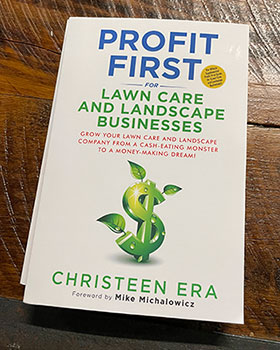 The book adapts Profit First principles to the landscape industry. It presents business models for different types of landscape businesses in different areas of the country. Steve says they start with 2 basic business classifications:
The book adapts Profit First principles to the landscape industry. It presents business models for different types of landscape businesses in different areas of the country. Steve says they start with 2 basic business classifications:- There’s the 3-ring circus, the company that does everything, lawn care, hardscaping, mowing.
- Then there's the 1-trick pony, the company that just that does one thing.
Steve says, “And then we took those, and we made different business models based on location, and whether they shut down in the winter, whether they transitioned over to snow removal, whether they were down south and ran all year round. Or, if they were down south, but had a high exposure to natural disasters like hurricanes.”
“Then we built these tools where you plug in information based on your business model, and then it tells you your percentages, where you should be as far as spending on payroll, admin, overhead.
“And there’s a scalable growth model that modifies where your numbers should be based on your annual sales. If you're at less than a million, this is what your percentages should be. If you're $1 million to $2.5 million, this is what your percentages should be, and so on. So it lays out what your financials need to look like at each stage, based on your business model and your location.”
They created the models based on research from the National Association of Landscape Professionals (NALP), PROOF Management and NAICS business classification data. Then they adjusted those numbers based on real life experience.
The goal was to create models that contractors can modify to match to their type of company in their location. So, you can see the correct ratios for your business at each revenue level.
Steve says, “This gives you a playbook on the what, where and when for managing your money and growth. It takes the guess work out of things like how much the owner should get paid, when to add a sales person, and when/how much admin should you have in your business.”
Today, Steve’s company operates just 2 divisions, one for lawn care applications and one for hardscape/landscape installation. Each is well managed by quality people to the point where Steve can vacation at peak season and everything runs fine without him.
He can also spend more time helping other contractors, which is something he finds extremely rewarding.
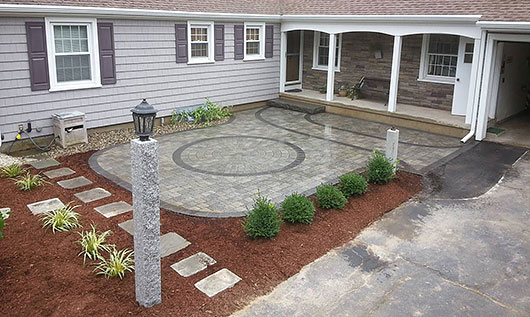
Steve says his installation division is poised for growth – if they can find employees with the all-around skills needed to do the work. “I have a great landscape manager who knows how to do everything.”













